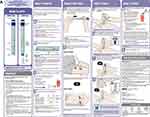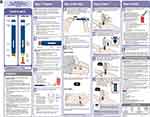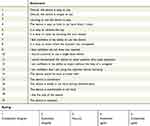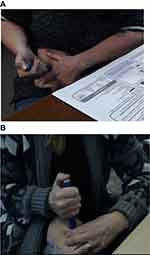Back to Journals » Patient Preference and Adherence » Volume 14
Patient Reported Ease-of-Use with a Disposable Autoinjector in Individuals with Migraine
Authors Mead J , Dammerman R, Rasmussen S
Received 7 February 2020
Accepted for publication 28 May 2020
Published 8 July 2020 Volume 2020:14 Pages 1137—1144
DOI https://doi.org/10.2147/PPA.S248584
Checked for plagiarism Yes
Review by Single anonymous peer review
Peer reviewer comments 2
Editor who approved publication: Dr Johnny Chen
Jennifer Mead, Ryan Dammerman, Soeren Rasmussen
Amgen Inc., Thousand Oaks, CA, USA
Correspondence: Jennifer Mead
Amgen Inc., One Amgen Center Dr, Thousand Oaks, CA 91320– 1799 Email [email protected]
Purpose: Erenumab-aooe (erenumab, Aimovig®)—a fully human monoclonal antibody that inhibits the calcitonin gene-related peptide (CGRP) receptor—is approved for the prevention of migraine in adults in a number of countries. The approved monthly dosage of erenumab (70 and/or 140 mg, depending on the country) is available as a single, prefilled autoinjector for subcutaneous administration in most countries where it is approved. This study evaluated the patient-reported ease-of-use, ability to learn self-injection, confidence in performing a simulated self-injection, and ergonomics of a prefilled autoinjector device for erenumab (SureClick® autoinjector) in individuals in the US with migraine.
Patients and Methods: Participants with migraine headaches, all of whom were naïve to the use of an autoinjector for migraine or another condition and CGRP therapy, were recruited from three US-based headache centers. Each participant received a supervised demonstration of the autoinjector during a 30-minute one-on-one session using a standard protocol-driven script. Participants then practiced a simulated injection into an artificial tissue pad using the autoinjector and were asked to rate their agreement with 19 statements about the device on a 5-point Likert scale (1 = completely disagree, 2 = somewhat disagree, 3 = neutral, 4 = somewhat agree, 5 = completely agree).
Results: Participants who completed the study and provided responses (n = 204) were between 21 and 85 years of age, inclusive, and 73% were female. More than 90% of the participants completely or somewhat agreed with 16/19 statements relating to the device, including ease-of-use, ability to self-inject, and confidence in using the device, with an average rating of > 4.5 on the 5-point Likert scale. Participants rated the size of the device and the compactness of the device as 4.23/5 and 4.26/5, respectively.
Conclusion: The erenumab-prefilled disposable autoinjector was consistently highly rated across categories by individuals with migraine, with an average rating of > 4.5 on the 5-point Likert scale; results were consistent across the three study centers.
Keywords: autoinjector, erenumab, migraine, subcutaneous injection, ease of use, calcitonin gene-related peptide
Introduction
Approved biologic therapies are typically self-injected via prefilled syringes or auto-injectors.1–4 These technologies aim to address challenges associated with self-injection including injection anxiety and a lack of patient self-confidence in accurate injection.5 Prefilled syringes ensure accurate dosing, sterility, and improved safety.6 Consequently, the development of self-injection devices has improved patient acceptance of injections, ease of use compared with the conventional needle and syringe,7 and patient experience and preference.8 Newer autoinjector technologies are designed to further ease patient burden, facilitate self-injection, and improve treatment adherence and convenience;6,8 these are considered by healthcare professionals to be advantageous to manual syringe injections.9 In a recent study, participants reported a high likelihood (86% very likely or somewhat likely) of adherence to treatment using an autoinjector device.10
Erenumab was the first calcitonin gene-related peptide (CGRP) pathway-targeted monoclonal antibody approved by the US Food and Drug Administration and the European Medicines Agency for the preventive treatment of migraine in adults.4,11–13 It is administered monthly/4-weekly in doses of 70 and 140 mg via subcutaneous injection via a single-dose prefilled SureClick® disposable autoinjector device. The autoinjector device was designed with features to enhance patient experience.4 For example, each disposable autoinjector is supplied in a single prefilled dose to ensure sterility, improve dosing accuracy and safety, and reduce the time needed to inject. Visible needles are considered a potential barrier to patient adherence to self-injection;10 therefore, the needle in the autoinjector device is shielded prior to use, alleviating needle phobia and risk of inadvertent needle stick injury. Finally, its shape and size is easy to hold in one hand, easy to operate with one click of the button, and it provides auditory and visual feedback when the injection is complete.
The objective of this study was to evaluate satisfaction (ease-of-use, the ability to learn self-injection, confidence in performing self-injections, and look and feel) with the sample single-dose, prefilled autoinjector device for erenumab among individuals with migraines. This study did not evaluate performance-based usability of the autoinjector device or clinical efficacy and safety, as injections were administered by the participant into an injection pad and no study drug was administered.
Patients and Methods
Study Design
This US-based multicenter study occurred between March 4 and March 13, 2019, at three test facilities in Chicago, IL; Oakbrook Terrace, IL; and Atlanta, GA. Institutional Review Board approval was not required as study participants simulated drug administration into an injection pad using a sample autoinjector device prefilled with sterile fluid and did not inject into their body (Figure 1). The prototype autoinjector devices were identical to the commercially available device, but were labelled “not for medical use,” “contains a sterile needle,” “does not contain drug,” and “not for sale,” and contained sterile fluid rather than any study drug. Participants were not asked to evaluate labelling content.
 |
Figure 1 Photograph of the injectors. |
Evaluations and data gathered about the device were based upon the personal experience and perspective of the user. The study employed a 30-minute one-on-one interview in which a session moderator guided the participants to operate the prototype autoinjector using the Instructions for Use (IFU) (Figure 2), allowing participant familiarization with the device for up to 10 minutes. Per the IFU, participants were informed that they were using a device containing a sterile needle and fluid, and were instructed not to remove the needle cap until injection. Each study session was live- streamed remotely to the onsite study sponsor, and participant identification was blinded. Patients were aware that the sponsor may or may not be observing, and were instructed not to state their name while in the room or any medications they are taking. The study setting included tables, chairs, and a microphone. Participant actions were captured via two cameras, one overhead and another to capture the patient during injection simulation, but cameras were pointed at participant hands or action areas, not at the participant’s face. An observer watched the live video feed from an adjacent room during the entire session to allow for intervention as needed to avoid risk to the patient during the simulated autoinjector use (ie, needle stick injury, inadvertent self-administration of sterile test fluid).
 |
Figure 2 Continued. |
 |
Figure 2 Autoinjector instructions for use. (A) Autoinjector: 70 mg/mL. (B) Autoinjector: 140 mg/mL. |
Participants
In total, 226 participants were recruited by a third-party telephone screen, with the goal of including those with a migraine diagnosis who were 21 to 85 years of age, predominantly female, and 100% autoinjector- and anti–CGRP therapy-naïve. Recruited participants were either from a recruiter’s pre-existing database of potential participants or were identified through their response to targeted ads on social media, specifically looking for those with interest in migraine information. Patients from the latter group were then screened to ensure eligibility. Exclusion criteria included current or past erenumab use, a pacemaker, blindness, aged 86 or older, and study participation with the sponsor in the previous 6 months. All participants provided signed informed consent.
Study Assessments
Participants were randomly assigned to use the 70 mg or 140 mg autoinjector, with 50% of each user group injecting into an artificial skin pad placed on the thigh, and the other 50% injecting into an artificial skin pad placed on the abdomen (Figure 3). Immediately following the skin pad injection, participants provided feedback on the use and characteristics of the device by rating their agreement with 19 statements (ie, ease-of-use, learnability, confidence self-injecting, and look and feel) using a 5-point Likert scale questionnaire (1 = completely disagree, 2 = somewhat disagree, 3 = neutral, 4 = somewhat agree, 5 = completely agree) (Table 1).
 |
Table 1 Study Survey and Rating Scale |
 |
Figure 3 Simulated injections were performed using an artificial injection pad. (A) Simulation of an abdomen injection. (B) Simulation of a thigh injection. |
Data Analysis
During each test session, the observer recorded all activities performed by the participants including participants’ ease-of-use, learnability, confidence self-injecting, and look and feel. Average (mean) ratings and the top two box scores were then calculated for each statement across all participants at all study sites. The observer recorded the participants’ performance parameters to support disposition and root cause analyses. All averages and top two box scores were calculated in Microsoft Excel (Redmond, WA). Qualified researchers may request data from Amgen clinical studies. Complete details are available at http://www.amgen.com/datasharing.
Results
Participant Population
A total of 226 participants were recruited into the study, of which 204 (73% female, 27% male) completed the study. Twenty-two participants with prior autoinjector experience (ie, Epi-Pen® [epinephrine injection, USP] and insulin injectors) were excluded, and one participant refused to wear the injection pad for the injection simulation stage and was dismissed.
Participant Device Acceptance
More than 90% of participants completely or somewhat agreed with 16/19 statements on ease-of-use of the device, ability to self-inject, and patient confidence in using the device, with an average rating of >4.5 on a 5-point Likert scale (Table 2). A total of 79% (161/204) of participants completely agreed that the autoinjector was easy to use, and 82% (168/204) completely agreed that the device was simple to use (Table 3). Over 84% (173/204) of participants completely agreed that the device was easy to inject by pressing the start button, 80% were confident in their ability to use the device, and 69% were confident that they were using the injection device correctly (Table 3). Statements related to preference of the size of the device and its compactness were rated 4.23 and 4.26, respectively. No protocol amendments were made, and no adverse events were reported during the study.
 |
Table 2 Participant Ratings on the Ease of Use of the Autoinjector |
 |
Table 3 Participant Rating Distribution on the Ease of Use of the Autoinjector |
Discussion
This study was designed to gain insight into participant perspective about the ease of use of the prototype single-dose autoinjector device. All participants were naïve to the use of the autoinjector. Participants rated the prototype on a 5-point Likert scale based on agreement or disagreement with 19 statements relating to ease-of-use, ability to self-inject, self-confidence in using the device, and look and feel. The prototype received high ratings from the majority of participants on ease-of-use, ability to self-inject, and self-confidence in using the device. These findings demonstrate that the prefilled autoinjector device for erenumab was well received. Following a one-on-one instructional session, participants felt confident in their ability to self-inject with the device.
The goal of this study was not to assess injection tolerability, as this has been thoroughly investigated in Phase 2 and Phase 3 clinical trials demonstrating that erenumab was well tolerated with an absence of dose-dependent injection-related events.14–16
The prototype autoinjector device was well received among individuals with migraine. A limitation of the study included the subjective nature of participant ratings. Furthermore, the study was not designed to collect performance-based usability or clinical data on the prototype autoinjector. Another potential limitation is that the study took place in a controlled environment that differs from participants’ home settings. In addition, participants were injection-naïve and only performed one injection. Thus, findings reported here are limited to first-time users and do not demonstrate if there is a learning curve. These study limitations are not expected to affect the utility of study data or the conclusions drawn from this study. The device was stable and easy to use in autoinjector-naïve participants. The high ratings of the autoinjector in this study indicate that the device is ideal for the administration of migraine therapy among individuals with migraines.
Conclusion
The SureClick® disposable autoinjector device was given high ease-of-use ratings, with an average rating of >4.5 on the 5-point Likert scale by study participants, suggesting that it provides an optimal method for the administration of erenumab. Ratings for study participants were uniformly positive across rating categories and three study centers, suggesting that the design of the device is suitable for and accessible to individuals with migraines.
Acknowledgments
This study was funded by Amgen Inc. The authors would like to thank the participants and research personnel for their assistance in this study. Medical writing and editorial support were provided by Marie-Louise Ricketts, PhD; and Claire Daniele, PhD, of AlphaBioCom (King of Prussia, PA), and funded by Amgen Inc.
Author Contributions
All authors contributed to the study design, data collection and interpretation, data analysis, drafting or revising the article, gave final approval of the version to be published, and agree to be accountable for all aspects of the work.
Disclosure
Jennifer Mead and Soeren Rasmussen are employees of Amgen Inc., and hold Amgen Inc., stock/stock options. Ryan Dammerman was an employee of Amgen Inc., at the time the study was conducted. The authors report no other conflicts of interest in this work.
References
1. HUMIRA® (adalimumab) injection, for subcutaneous use. Full prescribing information. North Chicago, IL: AbbVie Inc; 2019.
2. TREMFYA® (guselkumab) injection, for subcutaneous use. Full prescribing information. Horsham, PA: Janssen Biotech, Inc; 2019.
3. Enbrel® (etanercept) injection, for subcutaneous use. Full prescribing information. Thousand Oaks, CA: Amgen Inc; 2019.
4. Aimovig® (erenumab-aooe) injection, for subcutaneous use. Full prescribing information. Thousand Oaks, CA: Amgen Inc; Novartis Pharmaceuticals Corporation, East Hanover, NJ; 2019.
5. Keininger D, Coteur G. Assessment of self-injection experience in patients with rheumatoid arthritis: psychometric validation of the Self-Injection Assessment Questionnaire (SIAQ). Health Qual Life Outcomes. 2011;9:2. doi:10.1186/1477-7525-9-2
6. Makwana S, Basu B, Makasana Y, Dharamsi A. Prefilled syringes: an innovation in parenteral packaging. Int J Pharm Investig. 2011;1(4):200–206. doi:10.4103/2230-973X.93004
7. Sauer M, Abbotts C. A new pen device for injection of recombinant human growth hormone: a convenience, functionality and usability evaluation study. Patient Prefer Adherence. 2018;12:27–34. doi:10.2147/PPA.S149412
8. van den Bemt BJF, Gettings L, Domanska B, Bruggraber R, Mountian I, Kristensen LE. A portfolio of biologic self-injection devices in rheumatology: how patient involvement in device design can improve treatment experience. Drug Deliv. 2019;26(1):384–392. doi:10.1080/10717544.2019.1587043
9. Lange J, Richard P, Bradley N. Usability of a new disposable autoinjector platform device: results of a formative study conducted with a broad user population. Med Devices. 2015;8:255–264. doi:10.2147/MDER.S85938
10. Gandell DL, Bienen EJ, Gudeman J. Mode of injection and treatment adherence: results of a survey characterizing the perspectives of health care providers and US women 18–45 years old. Patient Prefer Adherence. 2019;13:351–361. doi:10.2147/PPA.S187120
11. Aimovig (erenumab). Summary of product characteristics. Nuremberg, Germany: Novartis Pharma GmbH; 2019.
12. Aimovig (erenumab-aooe) Product monograph. Dorval, Quebec: Novartis Pharmaceuticals Canada Inc; 2019.
13. Dolgin E. First GPCR-directed antibody passes approval milestone. Nat Rev Drug Discov. 2018;17(7):457–459. doi:10.1038/nrd.2018.103
14. Goadsby PJ, Reuter U, Hallstrom Y, et al. A controlled trial of erenumab for episodic migraine. N Engl J Med. 2017;377(22):2123–2132. doi:10.1056/NEJMoa1705848
15. Tepper S, Ashina M, Reuter U, et al. Safety and efficacy of erenumab for preventive treatment of chronic migraine: a randomised, double-blind, placebo-controlled phase 2 trial. Lancet Neurol. 2017;16(6):425–434. doi:10.1016/S1474-4422(17)30083-2
16. Dodick DW, Ashina M, Brandes JL, et al. ARISE: a phase 3 randomized trial of erenumab for episodic migraine. Cephalalgia. 2018;38(6):1026–1037. doi:10.1177/0333102418759786
 © 2020 The Author(s). This work is published and licensed by Dove Medical Press Limited. The full terms of this license are available at https://www.dovepress.com/terms.php and incorporate the Creative Commons Attribution - Non Commercial (unported, v3.0) License.
By accessing the work you hereby accept the Terms. Non-commercial uses of the work are permitted without any further permission from Dove Medical Press Limited, provided the work is properly attributed. For permission for commercial use of this work, please see paragraphs 4.2 and 5 of our Terms.
© 2020 The Author(s). This work is published and licensed by Dove Medical Press Limited. The full terms of this license are available at https://www.dovepress.com/terms.php and incorporate the Creative Commons Attribution - Non Commercial (unported, v3.0) License.
By accessing the work you hereby accept the Terms. Non-commercial uses of the work are permitted without any further permission from Dove Medical Press Limited, provided the work is properly attributed. For permission for commercial use of this work, please see paragraphs 4.2 and 5 of our Terms.
